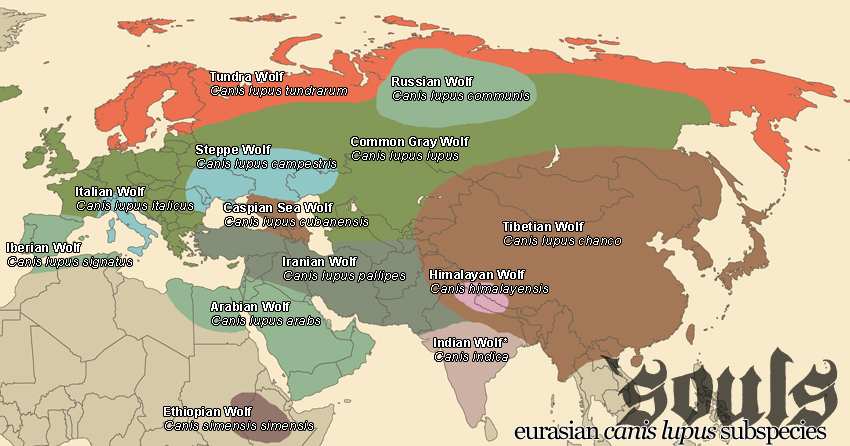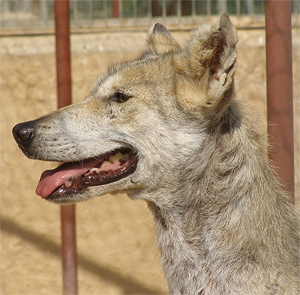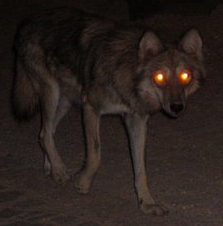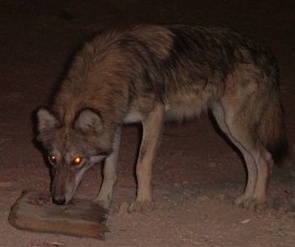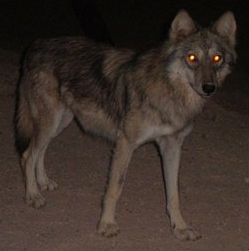Arabian Wolf (''Canis lupus arabs'')
See our RP Guide for more extensive information regarding wolves.
On this page... (hide)
- 1. Common Names
- 2. 'Souls Range
- 3. Appearance
- 4. Other Characteristics
- 4.1 Social Structure
- 4.2 Habitat
- 4.3 Diet
- 4.4 Survival
- 4.5 Luperci
- 5. More Images
- 6. Citations
1. Common Names
Arabian Wolf
2. 'Souls Range
Throughout the Arabian penninsula.
3. Appearance
Canis lupus arabs, from commons.wikimedia.org
The Arabian wolf is a small, desert adapted wolf, greatly varying from the nominative Common Gray Wolf. It stands around 26 inches (66 cm) at the shoulder, weighing an average 40 pounds (18 kg). This is a vast difference from the 150 pound (68 kg) specimens sometimes found in northerly examples of the Gray Wolf.
The Arabian wolf's desert-readiness gives it several adaptations unique to its subspecies: the ears are proportionately larger than most other subspecies, and their middle toes in their paws are fused, both thought to be adaptations advantageous to living in an arid, desert environment.
They are typically a tawny gray or dusky brown in coloration, with slightly darker backsides and lighter-colored undersides. Unlike many other subspecies, black and white are rare in Arabian wolves. They have short, thin fur in summer, though the hair on their back remains long even in summer. It is thought that this is an adaptation against solar radiation. The winter coat is long, though not as long as northern subspecies. It is distinguished from the Iranian Wolf by its paler fur, smaller size and proportionally smaller head.
4. Other Characteristics
4.1 Social Structure
Arabian wolves rarely live in the large, structured packs of their northerly cousins; groups of three or four will hunt together, but typically do not live together. They are most commonly sighed alone or in pairs. These canines tend to prefer a nomadic lifestyle -- it is rare to find an Arabian wolf settled down into a Luperci city.
4.2 Habitat
Arabian wolves inhabit arid, desert-like conditions, though they cannot survive on the extreme arid interior of the Arabian peninsula. Some live in mountainous regions in Israel.
4.3 Diet
Arabian wolves will hunt small to medium sized animals such as cape hares, Dorcas Gazelles and ibexes, though they will readily scavenge. As they are adapted to a harsh environment where food is extremely scarce, they are typically resourceful eaters.
4.4 Survival
Arabian wolves were somewhat uncommon prior to the extinction of humans; prior to the extinction of mankind, this wolf's range was reduced to “small pockets in Southern Israel, Southern and western Iraq, Oman, Yemen, Jordan, Saudi Arabia, and ... some parts of the Sinai Peninsula.”1 However, the Arabian wolves were quickly able to recovere their numbers and inherited various Luperci traits and humanized lifestyles from Europe.
4.5 Luperci
Most Arabian wolves are Luperci; it is rare to find them living as feral canines, as they are in the more civilized areas of the world. However, as with any canine population, one can find canines living a feral lifestyle by choice or tradition.
5. More Images
6. Citations

